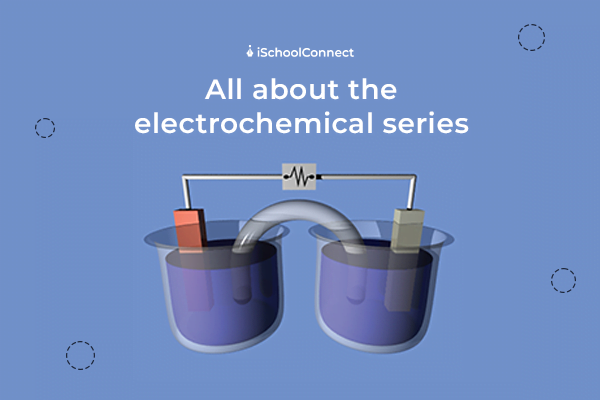Table of Contents
Electrochemical Series
If you are someone looking to pursue your higher education in the science field abroad, a basic expectation any university will have from you is well-rounded knowledge of the electrochemical series. It may seem difficult at first glance, but this comprehensive guide is your answer to learning all you need to know about the series. Read on and prepare for your future well!
Created by comparing different electrode potentials to conventional hydrogen electrodes, the electrochemical series helps in the arrangement of components. It defines the sequence of rising potential values of the electrodes for the structure of the elements. The electrodes (metals and non-metals) interface with their ions in an electrochemical series and organize according to their reduction potentials’ magnitude.
Electrochemical Series List
| Element | Electrode Reaction (Reduction) | Standard Electrode Reduction Potential E° (in volt) |
| Li | Li+ + e- → Li | -3.05 |
| K | K+ + e- → K | -2.925 |
| Ca | Ca2+ + 2e- → Ca | -2.87 |
| Na | Na+ + e- → Na | -2.714 |
| Mg | Mg2+ + 2e- → Mg | -2.37 |
| Al | Al3+ + 3e- → Al | -1.66 |
| Zn | Zn2+ + 2e- → Zn | -0.7628 |
| Cr | Cr3+ + 3e- → Cr | -0.74 |
| Fe | Fe2+ + 2e- → Fe | -0.44 |
| Cd | Cd2+ + 2e- → Cd | -0.403 |
| Ni | Ni+ + 2e- → Ni | -0.25 |
| Sn | Sn2+ + 2e- → Sn | -0.14 |
| H2 | 2H+ + 2e- → H2 | 0.00 (Standard) |
| Cu | Cu2+ + 2e- → Cu | +0.337 |
| I2 | I2 + 2e- → 2I- | +0.535 |
| Ag | Ag+ + e- → Ag | +0.799 |
| Hg | Hg2+ + 2e- → Hg | +0.885 |
| Br2 | Br2 + 2e- → 2Br- | +1.08 |
| Cl2 | Cl2 + 2e- → 2Cl- | +1.36 |
| Au | Au3+ + 3e- → Au | +1.50 |
| F2 | F2 + 2e- → 2F- | +2.87 |
Learn about: Chemical Engineering | Courses, Skills, Jobs and More
Electrochemical Series Applications
There are many applications of electrochemical series, such as:
Reduction and oxidation strengths
- The electrochemical series helps identify different materials that are good reducing and oxidation agents.
- All substances that appear on top of the electrochemical series act as good reduction agents.
- All such substances that appear at the bottom of the electrochemical series act as good oxidation agents.
Displacement reaction
- A substance or metal higher in the electrochemical series will evict a material from its lower-in-the-series solution.
- As a matter of fact, a higher metal in the series tends to supply electrons to the metal’s cations.
- The substance with a lower standard of reduction potential will displace the metal from the salt solution with a greater value.
Prediction of metals’ ability to liberate hydrogen gas from acid
- All metals with negative electrode potential (-E) have an increased tendency to lose electrodes compared to Hydrogen.
- Hence, when such a substance is placed in an acid solution, it gets oxidized, and an effective reduction of H+ ions occurs to form hydrogen gas.
- Therefore, substances having -E values have the potential to free Hydrogen from different acids.
Predicting the feasibility of the redox reaction
- Based on the values of E of the two different electrodes, the electrochemical series can predict the feasibility of the provided redox reaction.
- However, it is possible only if the substances with greater potential reduce, while those with lesser potential lose their electrons or oxidize.
Calculation of the cell of EMF
- All in all, if the EMF of the substance’s cell is positive, the reaction is feasible.
- As a matter of fact, a feasible reaction represents the cell effectively.
- However, when it is negative, the reaction of the cell is not feasible, leading to an inaccurate cell representation.
Comparison of the reactivity of different metals
- As a matter of fact, the oxidation or reduction of various substances and ions is known through the electrochemical series.
Benefits of The Electrochemical Series
Comparison of various metals’ respective oxidizing and reducing powers
- A positive value implies that the electrode has a higher reduction potential.
- Hence, it works as a more powerful oxidizing agent.
- However, a negative value indicates that the electrode’s reduction potential is weaker.
- Therefore, it implies that it is a more efficient reducing agent.
Comparing the relative energies of metals in displacement processes basis their placement in the activity series!
- All in all, the metals displacing processes are cation displacement reactions.
- Hence, the rule “the metal that produces the cation can only displace the cation, as well as the metal that creates the anion can displace any anion” applies.
- The higher a metal’s oxidizing potential, the faster it may lose electrons.
- Therefore, it leads to higher reactivity.
- As a matter of fact, it indicates that metals with greater inactivity series can supplant metals with lower reactivity.
Check out: Best Chemical Engineering Universities in the USA
The Reactive Series
K > Na > Ca > Mg > Al > Zn > Fe > Ni > Sn > Pb > H > Cu > Hg > Ag > Au > Pt >
Electrochemical Series Properties
1) Non-metallic SRP is often higher than Hydrogen SRP.
2) However, Hydrogen SRP is more than metallic SRP.
3) Oxidizing agents are found in elements with a higher SRP.
4) Fluorine has the greatest SRP, and Lithium has the lowest SRP.
5) Therefore, indicating that fluorine is the most oxidant and Lithium is the least oxidant.
Discover this guide to pursue Masters in chemical engineering in Canada
Electrochemical Series Tricks
Here are a few easy tricks for students to memorize the electrochemical series:
An easy mnemonic to memorize the series
KINGS CAN NOT MAKE A ZEBRA. I LIKE HIS CAR’S SILVERY GATE
- Kings- POTASSIUM
- Can- CALCIUM
- Not- (NA)SODIUM
- Make- MAGNESIUM
- A– ALUMINUM
- Zebra- ZINC
- I – IRON
- Like- LEAD
- His- HYDROGEN
- Car’s-COPPER
- Silvery- SILVER
- Gate- GOLD
Check if a particular metal is more or less reactive than Hydrogen.
- The electrochemical series shows Hydrogen positioning between copper and lead.
- Hence, remember that metals on the left-hand side of Hydrogen are more reactive, while those on the right-hand side are less reactive.
To forecast if metal would give out hydrogen gas when it combines with acid.
- Remember that metal oxidization and hydrogen ion reduction happen by electron absorption.
- Hence, negative reduction metals above Hydrogen in an electrochemical series enhance its potential to react with any acid.
- Therefore, leading to the production of Hydrogen in the form of gas.
To figure out the standard EMF of the electrochemical cell.
- Electromotive force (EMF) is the difference between both the anode and cathode of a cell.
- Hence, adding the standard electrode potentials of two half-cells results in the cell’s standard EMF.
E0 cell = E0 oxidation + E0 reduction
- In addition to this, remember that the standard oxidation potential is equal to the standard reduction potential.
- Because the anode is the negative electrode for oxidizing and the cathode is the positive terminal for reduction, the formula is
E0 cathode + E0 anode = E0 cell
Explore: Top 8 Chemical Engineering Jobs
Key Takeaways
- According to the definition of electrochemical series, the conventional reduction potential of any substance is the measurement of an element’s likelihood to undergo reduction.
- The electrochemical series considers an element’s reduction potential in terms of the hydrogen scale, where Eo = zero.
- The larger an element’s reducing potential, the easier it is to decrease it. Elements with a low reduction potential, on the other hand, will oxidize considerably more quickly and readily.
- Elements that readily give up electrons, on the other hand, have a negative potential.
- However, positive reduction potential elements do not readily give away electrons but readily receive them.
If you wish to know more about the electrochemical series, get in touch with us today!
Liked this blog; read next Engineering Physics | Deep Insights about the Course!
FAQs
Ques 1: What is the electrochemical cell’s standard EMF formula?
Answer 1: The formula of the electrochemical cell’s standard EMF is E0 cell = E0 oxidation + E0 reduction.
Ques 2: What is a conventional hydrogen electrode’s electrode potential value?
Answer 2: A standard hydrogen electrode has an electrode potential of 0.0 V.
Ques 3: What does a lower element’s reduction potential imply?
Answer 3: The low reduction potential of any substance indicates that it is easily oxidized.







It is too good.